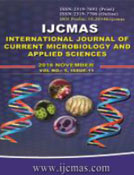


 National Academy of Agricultural Sciences (NAAS)
National Academy of Agricultural Sciences (NAAS)

|
PRINT ISSN : 2319-7692
Online ISSN : 2319-7706 Issues : 12 per year Publisher : Excellent Publishers Email : editorijcmas@gmail.com / submit@ijcmas.com Editor-in-chief: Dr.M.Prakash Index Copernicus ICV 2018: 95.39 NAAS RATING 2020: 5.38 |
Outbreaks of infection caused by strains of A. baumannii resistant to multiple antibiotic classes, including carbapenems, are a serious concern in many specialized hospital units, including intensive care units (ICUs) Clinical isolates of Acinetobacter species initially retained at least partial susceptibility against the 3rd and 4th generations viz cephalosporins, fluoroquinolones, semisynthetic aminoglycosides, carbapenems and 100% susceptibility to imipenem but the clinical utility of this class of antimicrobial is increasingly being jeopardized by the emergence of both enzymatic and membrane-based mechanisms of resistance. The increase in the number of MBLs in A. baumannii is an ominous development in the global emergence of resistance to β-lactams. Keeping this things mind study was carried out to know the prevalence of ESBL & MBL producing Acinetobacter isolates in tertiary care hospital. A total of 31 no’s Acinetobacter isolation was done from clinical specimens from different medical wards, surgical wards and ICU department of GMCH for a period of one year from August 2014--July 2015. Isolated Acinetobacter spp were tested for ESBL (Extended spectrum Beta Lactamase) by double disc synergy and MBL (Matelo Beta Lactamese) by imipenem and Imepenem+EDTA E-test method. Out of the total of 31 Acinetobacter isolates, MDR isolates found to be 13(41.94%) of which A.baumannii 12(92.30%) and Acinetobacter lwoffii 1(7.69%). MDR Acinetobacter were sensitive to Polymixin B (100%) followed by Tigecycline, colistin (92.85%). Out of the total of 31 Acinetobacter isolates, 32.25 % isolates are ESBL producer and 38.7% of isolates were MBL producer and all MBL producers were isolated from ICU. Maximum MDR, ESBL and MBL isolation rates were seen from tracheal aspirates. In our study 32.25 % isolates and 38.7%of isolates were ESBL and MBL producer respectively and all MBL producers were isolated from ICU. Therefore early detection is necessary to screen and confirm beta lactamase mediated resistant strains to avoid treatment failure and prevent the spread of MDR.
 |
 |
 |
 |
 |